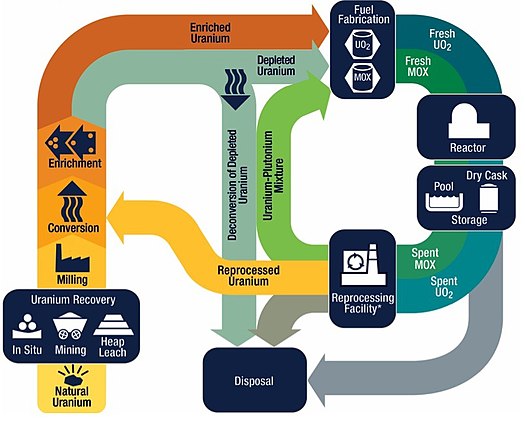As the global demand for clean energy surges, the nuclear fuel cycle—the backbone of sustainable nuclear energy—is emerging as a strategic pillar of energy planning. Amid challenges such as upstream material constraints, limited logistics capacity, lagging technological upgrades, and geopolitical disruptions, the nuclear industry is undergoing a fundamental structural transformation.

The expansion of nuclear power is accelerating faster than the capacity of its supporting fuel cycle infrastructure. While uranium resources remain plentiful, critical stages such as conversion, enrichment, and fuel fabrication are struggling to keep up:
Delayed expansion in enrichment capacity: Major suppliers like Urenco are scaling up, but not fast enough to match rising global reactor demand.
Bottlenecks in fuel fabrication: Aging facilities and outdated equipment hamper output, with a highly centralized supply network offering little redundancy.
Transport becoming a new vulnerability: Nuclear fuel logistics face barriers such as port licensing, ship certification, and liability frameworks. Shipping capacity is growing far slower than demand.
These issues underline a broader truth: Fuel supply bottlenecks are no longer just commercial risks—they are strategic vulnerabilities for national energy resilience.
In response, multiple nations are reconfiguring their fuel cycle strategies through localization, multilateral cooperation, and next-gen technologies:
The UK is reviving its Springfields fuel conversion facility to reduce reliance on foreign sources.
France is investing in advanced technologies like laser enrichment to boost high-value fuel production.
Uzbekistan is expanding uranium mining to reinforce its upstream influence.
The United States is building domestic HALEU (High-Assay Low-Enriched Uranium) capacity to support advanced reactor deployment.
These moves signal a broader shift: the global fuel cycle is pivoting toward a “regional self-reliance + strategic redundancy” model to mitigate uncertainty.
Innovation is transforming both the front and back ends of the nuclear fuel lifecycle:
Front-end advances:
Microstructured fuels like TRISO particles are entering trial phases, promising stable high-temperature performance for Gen IV reactors.
HALEU is becoming the core fuel for advanced reactors; the U.S. is building pilot production plants with commercial output expected by 2027.
Back-end breakthroughs:
Mixed fuels such as MOX and Remix reduce uranium usage and enhance recyclability.
Novel reprocessing techniques—dry separation, ion exchange—are being explored for lower-cost, lower-waste recovery.
Countries like Sweden, Finland, and Canada are advancing standardized and demonstrable deep geological disposal sites.
These trends reflect a clear direction: a shift toward closed-loop cycles and high-efficiency, low-waste fuel strategies.
Governments are crafting policies that promote nuclear fuel development while maintaining safeguards for safety and non-proliferation:
The U.S. has issued executive orders to fast-track small reactor deployment and pave the way for plutonium fuel use in select applications.
The EU emphasizes controlled growth, harmonized standards, and inter-member fuel sharing platforms.
Emerging markets (e.g., Eastern Europe, Central Asia) are developing fuel cycle capabilities in coordination with the IAEA to ensure safety accountability.
We are witnessing a paradigm shift from restrictive regulation toward incentive-driven, process-controlled oversight, aligned with technological realities and market needs.
Future leadership in nuclear fuel will depend on three dimensions:
Technological control: Dominance will favor those who master the full cycle—from mining to reprocessing—with high-efficiency tools.
Industrial integration: Resilience depends on local manufacturing, autonomous logistics, and circular fuel flows.
Policy coordination: Balancing safety, economic viability, environmental goals, and geopolitical positioning is key to sustainable fuel governance.
As nuclear energy reclaims center stage in the clean energy transition, a secure and robust fuel cycle is no longer a backend concern—it’s a strategic indicator of a country’s energy resilience and global competitiveness.